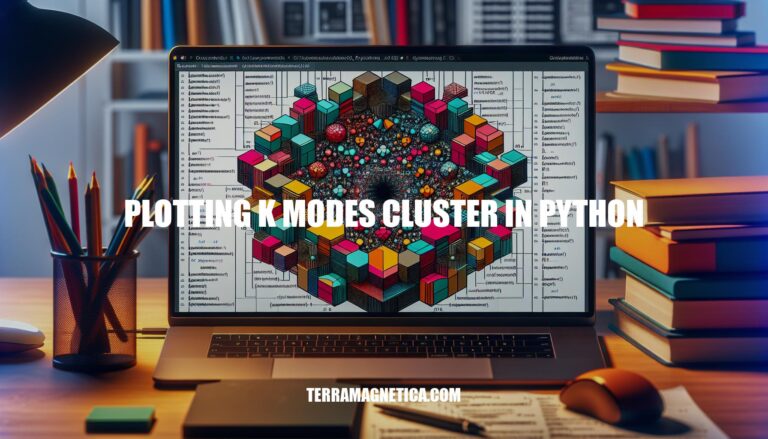


K-modes clustering is an unsupervised machine learning technique used to group data objects based on their categorical attributes. Unlike k-means, which uses means, k-modes uses modes (the most frequent values) to define clusters.
Plotting k-modes clusters in Python helps visualize these groupings, making it easier to interpret and analyze categorical data. This is particularly useful in applications like market segmentation, social network analysis, and bioinformatics, where understanding patterns in categorical data is crucial.
K-modes clustering is an algorithm designed for clustering categorical data. It works by grouping data points into clusters based on the most frequent values (modes) within each cluster, rather than using means as in k-means clustering.
Here are the steps to set up a Python environment for plotting K-Modes clusters:
Install Python:
Create a Virtual Environment:
python -m venv kmodes_env
Activate the Virtual Environment:
kmodes_env\Scripts\activate
source kmodes_env/bin/activate
Install Necessary Libraries:
pip install numpy pandas matplotlib kmodes
Import Libraries in Your Script:
import numpy as np
import pandas as pd
import matplotlib.pyplot as plt
from kmodes.kmodes import KModes
Prepare Your Data:
data = np.random.choice(20, (100, 10)) # Example random categorical data
Fit the K-Modes Model:
km = KModes(n_clusters=4, init='Huang', n_init=5, verbose=1)
clusters = km.fit_predict(data)
Plot the Clusters:
plt.scatter(data[:, 0], data[:, 1], c=clusters, cmap='viridis')
plt.title('K-Modes Clustering')
plt.show()
This setup will allow you to perform K-Modes clustering and visualize the results.
Here’s a concise guide to implementing k-modes clustering in Python:
Import Libraries:
import pandas as pd
from kmodes.kmodes import KModes
Load Data:
data = pd.read_csv('your_dataset.csv')
Preprocess Data:
Initialize K-Modes:
km = KModes(n_clusters=3, init='Huang', n_init=5, verbose=1)
Fit the Model:
clusters = km.fit_predict(data)
Analyze Results:
data['Cluster'] = clusters
print(data)
This will cluster your categorical data into the specified number of clusters using the k-modes algorithm.
To plot K-Modes clusters in Python, you can use the kmodes library along with matplotlib and seaborn for visualization. Here’s a step-by-step guide with code examples:
pip install kmodes matplotlib seaborn
import pandas as pd
from kmodes.kmodes import KModes
import matplotlib.pyplot as plt
import seaborn as sns
# Sample categorical data
data = {'Feature1': ['A', 'B', 'A', 'C', 'B', 'A'],
'Feature2': ['X', 'Y', 'X', 'Y', 'X', 'Y']}
df = pd.DataFrame(data)
km = KModes(n_clusters=2, init='Cao', n_init=5, verbose=1)
clusters = km.fit_predict(df)
df['Cluster'] = clusters
plt.figure(figsize=(8, 6))
sns.scatterplot(x='Feature1', y='Feature2', hue='Cluster', data=df, palette='viridis')
plt.title('K-Modes Clusters')
plt.show()
pip to install kmodes, matplotlib, and seaborn.seaborn to create a scatter plot of the clusters.This code will generate a scatter plot showing the clusters formed by the K-Modes algorithm. Adjust the features and number of clusters as needed for your specific dataset.
When interpreting plots from k-modes clustering, focus on the following key aspects:
Cluster Centroids: Each cluster is represented by a mode, which is the most frequent value for each categorical attribute within the cluster. Look at these centroids to understand the common characteristics of each cluster.
Cluster Distribution: Examine how data points are distributed across clusters. This can reveal the relative size and density of each cluster, indicating which clusters are more prominent or have more distinct patterns.
Dissimilarity Measures: Plots often show the dissimilarity (e.g., Hamming distance) between data points and their assigned cluster centroids. Lower dissimilarity values indicate that data points are well-matched to their clusters, while higher values suggest outliers or less cohesive clusters.
Parallel Coordinates Plot: This type of plot can be particularly useful for visualizing k-modes clustering results. It allows you to see how individual data points compare across all categorical variables, highlighting the differences and similarities within and between clusters.
By focusing on these aspects, you can gain insights into the structure and characteristics of your categorical data, helping you make informed decisions based on the clustering results.
You need to install required libraries such as `kmodes`, `matplotlib`, and `seaborn`. Then, import the necessary libraries and create a sample DataFrame with categorical data.
Apply K-Modes clustering by initializing and fitting the model to the data, predicting the clusters, and assigning them to the original DataFrame. Finally, use `seaborn` to create a scatter plot of the clusters.
Focusing on cluster centroids, distribution, dissimilarity measures, and parallel coordinates plots can provide valuable insights into your data.
By analyzing these aspects, you can gain insights into the structure and characteristics of your categorical data, making informed decisions based on the clustering results.